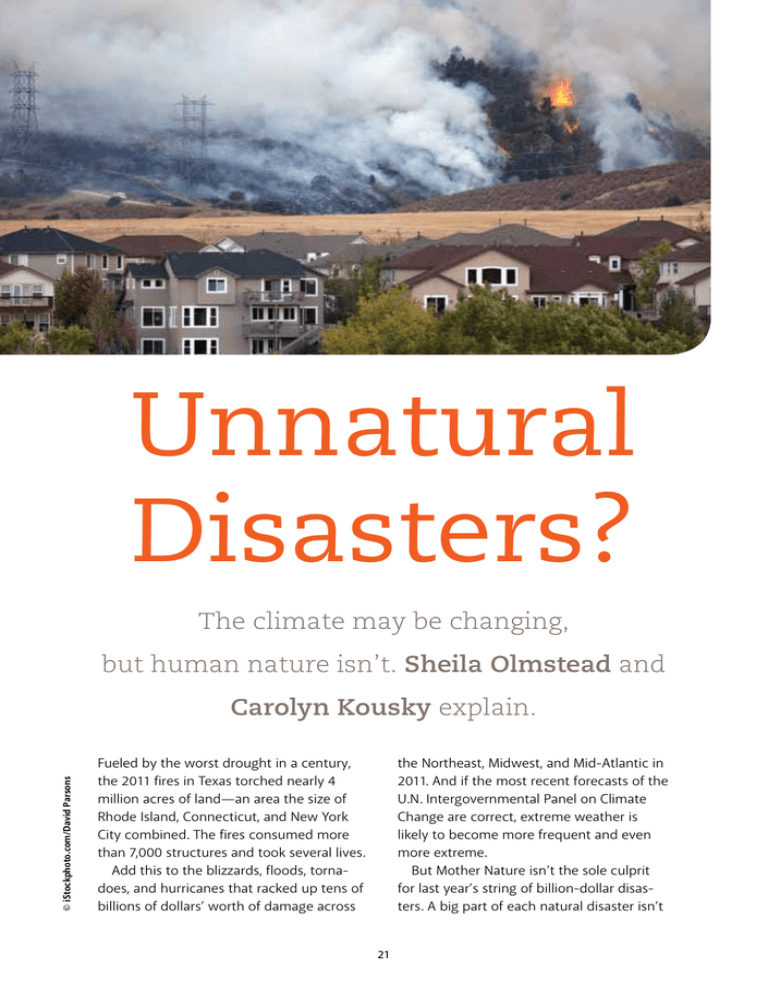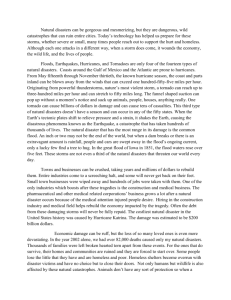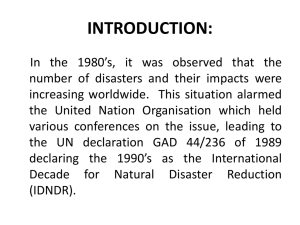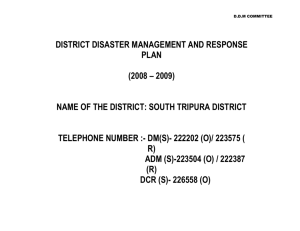Unnatural Disasters? The climate may be changing,
advertisement

Unnatural Disasters? The climate may be changing, but human nature isn’t. Sheila Olmstead and © iStockphoto.com/David Parsons Carolyn Kousky explain. Fueled by the worst drought in a century, the 2011 fires in Texas torched nearly 4 million acres of land—an area the size of Rhode Island, Connecticut, and New York City combined. The fires consumed more than 7,000 structures and took several lives. Add this to the blizzards, floods, tornadoes, and hurricanes that racked up tens of billions of dollars’ worth of damage across the Northeast, Midwest, and Mid-Atlantic in 2011. And if the most recent forecasts of the U.N. Intergovernmental Panel on Climate Change are correct, extreme weather is likely to become more frequent and even more extreme. But Mother Nature isn’t the sole culprit for last year’s string of billion-dollar disasters. A big part of each natural disaster isn’t 21 Induced Development in Risky Locations: Fire Suppression and Land Use in the American West RFF Fellows Sheila Olmstead and Carolyn Kousky are completing research testing the hypothesis that federal efforts to suppress wildfires in the western United States since 1970 have acted as a development subsidy, drawing new residential and commercial development into risky regions. The analysis exploits a natural experiment—a major shift in federal fire suppression policy that occurred in the aftermath of catastrophic fires in Yellowstone National Park in 1988. Results suggest that during periods when the federal government has intensified its expected suppression efforts on public lands, private residential and commercial development has accelerated on nearby land that would “natural” after all. Federal policy plays its role, and if we are indeed headed into a new era of wild weather, it’s time to make some changes. An important driver of rising disaster costs is not climate but the presence of more people and structures in harm’s way. Certain disasters, such as wildfires and floods, occur largely, if not exclusively, in identifiable high-risk areas. Moving out of these areas reduces your chances of being flooded or losing a home to a wildfire. Less drastic measures, such as fire-proofing your roof or clearing trees near your house, can also reduce that risk. Hazardous areas like coasts and dry forestland often are nice places to live: they have great views, access to recreation, and little noise and pollution. Floodplains can be fertile agricultural areas. There will always be development in these risky locations, and for much of this development, 22 © iStockphoto.com/BanksPhotos benefit from that suppression. the benefits surely will outweigh the costs of disaster damages. But certain public policies potentially are leading to too much development in some places we know are dangerous and too little investment in risk reduction, increasing losses when disasters do occur. U.S. wildfire suppression, for example, is largely funded by federal and state taxpayers, not homeowners in fire-prone places, creating an implicit incentive to develop ment” below.) There may be distributional or other benefits arising from these subsidies, but we need to be more discriminating about when and which development costs are borne by the general taxpayer. Federal polices can alter the incentives individuals face to locate in hazardous areas, purchase disaster insurance, or invest in risk-reducing measures. But to date, there is only a small amount of empirical evidence on the magnitude of the intended and Certain public policies potentially are leading to too much development in places we know are dangerous and too little investment in risk reduction. these areas. Our research confirms that in the western United States, development is greater on lands benefiting from federal suppression efforts, all else equal. (See “Induced Development in Risky Locations” on page 22.) In a similar vein, subsidized crop and flood insurance can encourage farming or development in areas that individuals may have avoided, were it not for federal funds. (See “Improving the Corps of Engineers’ Contribution to National Flood Risk Manage- unintended influences of federal policies on individual and community decisionmaking vis-à-vis natural hazards. Researchers at RFF are beginning to fill this gap. With forecasts of extreme events increasing, it is time to look at the impacts of federal disaster risk management policies before tragedy strikes. RFF research will inform the development of disaster policies that consider not just the climate but also human nature. Improving the Corps of Engineers’ Contribution to National Flood Risk Management Leonard Shabman, a resident scholar at RFF, is leading a study on flood risk management policy with Carolyn Kousky and colleagues at other institutions. The study recommends replacing the federal focus on projects and programs to secure flood damage reduction with a more decentralized approach. At the heart of this new approach are two objectives. The first is to improve individuals’, businesses’, and local communities’ understanding of their flood risk. To do so, the federal government must clarify the capabilities and limits of its programs to reduce and manage such risk. The second goal is to assure that nonfederal interests take responsibility for the consequences of their decisions to locate in areas that may flood—and for implementation of any riskreducing measures. 23






